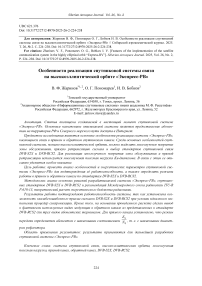Features of the implementation of the satellite communication system in the highly elliptical orbit “Express-RV”
Автор: Zharinov V.F., Ponomarev O.G., Bobkov I.V.
Журнал: Siberian Aerospace Journal @vestnik-sibsau-en
Рубрика: Aviation and spacecraft engineering
Статья в выпуске: 2 vol.26, 2025 года.
Бесплатный доступ
This article addresses the Express-RV satellite system, which developers are currently creating. Its primary purpose is to provide subscribers in the Russian Federation and the Northern Sea Route with internet access. The subject of the study is the main features of the Express-RV system implementation, concerning communication in the forward and reverse satellite channel. Among the main features of the satellite system, in addition to the highly elliptical orbit (HEO), we can highlight multi-beam coverage of the service area, direct signal retransmission and the choice of DVB-S2X and DVB-RCS2 satellite communication standards. To implement multi-beam coverage of the service area and direct retransmission, the system employs a multi-beam Ku-band payload. Therefore, the work prioritizes the description of this payload. Objective of the work: to analyze the features and energy parameters of the Express-RV satellite system to confirm its operability, as well as to determine the operating modes in the forward and reverse channels according to the DVB-S2X and DVB-RCS2 standards. Methodology: analysis of the main solutions of the Express-RV system being developed, the DVB-S2X and DVB-RCS2 satellite standards and the recommendations of the International Radiocommunication Union ITU-R P.618-13, theoretical calculation of the energy budget of the radio link. The results confirm the system’s operability, as the study demonstrates the possibility of quasi-error-free reception of DVB-S2X and DVB-RCS2 signals under ideal synchronization conditions. In addition, based on the calculation, we identify the actually used types of modulation in the return channel from those presented in the DVB-RCS2 standard for 3 types of subscriber terminals. For the forward channel, the analysis reveals that the transmission mode adapts to the terminal with the smallest reflector diameter, eliminating benefits from larger-aperture terminals. Scope of application of the results: the researchers and engineers use the results to further develop the Express-RV satellite system.
Satellite communication system, highly elliptical orbit, multi-beam payload, forward link, return link, DVB-S2X, DVB-RCS2
Короткий адрес: https://sciup.org/148331242
IDR: 148331242 | УДК: 621.376 | DOI: 10.31772/2712-8970-2025-26-2-224-238
Текст научной статьи Features of the implementation of the satellite communication system in the highly elliptical orbit “Express-RV”
The constant growth of the transmitted data volume leads to the need of increasing the telecommunications infrastructure. All over the world, including in Russia, intensive research work is being carried out in the field of communication systems [1–3]. For Russia, about 80% of whose territory is not covered by cellular networks, the potential of satellite communication systems, as well as the feasibility and economic efficiency of their use, are further increased.
In response to the growing demand for satellite communications in Russia, work is underway to create several new-generation satellite constellations in non-geostationary orbits: Express-RV, Skif, Mara-thon-IoT, and Rassvet. The Express-RV satellite system, designed to provide fixed and mobile subscribers in Russia and the Northern Sea Route with Internet access, is of particular importance. According to estimates, up to 90% of Russia's northern territories are not covered by cellular and satellite networks. In the context of the country's technological sovereignty, its development is an important task.
This article is devoted to the main features of the Express-RV satellite system implementation. The key feature of the system is the multi-beam payload of the Ku-band, which solves the problems of multi-beam coverage of the service area and direct retransmission. The multi-beam payload determines the requirements for the entire satellite group, so in the work special attention is paid to its description. Another important feature of the satellite system is the choice of DVB-S2X and DVB-RCS2 standards for the design of modem equipment. To determine the operating modes in the forward and reverse channels, the energy budget of the radio link was calculated from all the standards available. Provided that the synchronization procedure is performed on the receiving side, the possibility of qua-si-error-free reception of radio frames of the DVB-S2X and DVB-RCS2 standards is established. Based on the obtained values, the types of modulation that will be used in the communication system in the forward and reverse channels are determined.
General characteristics of the Express-RV satellite system
Due to the requirement to cover high latitudes, when designing the satellite system, highly elliptical orbits (HEO) of the Molniya type were selected [4; 5]. The orbit parameters are presented in Table 1
HEO of the Molniya type parameters
Table 1
|
Major semi-axis, km |
26554 |
|
Eccentricity |
0,722 |
|
Inclination, º |
62,8 |
|
Number of spacecrafts (SC) |
4 |
|
Period of revolution, ч |
≈ 12 |
|
Longitude of the ascending node, º |
67,7/157,7/247,7/337,7 |
|
Argument at Perigee, º |
270 |
|
Duration of the working section of the orbit (WSO), h |
6 |
The Express-RV system includes four spacecraft (SC), the orbital planes of which are spaced 90° apart in longitude. The SC orbital period is approximately 12 hours, of which the working section of the orbit corresponds to the region of ±3 hours from the apogee. When the SC leaves the working section of the orbit, a switchover to the next spacecraft, orbiting in an adjacent plane, occurs. The orbital parameters are selected in such a way that the position of the subsatellite point changes slightly throughout the working section of the orbit. Due to this, a quasi-geostationary mode is ensured in the working section of the orbit. Each SC makes two orbits per day: the main and the conjugate. When operating on the main orbit, from which the territory of Russia is serviced, the ground orbital track is located above the Eastern Hemisphere. When functioning on the conjugate orbit, designed to cover the Arctic territories, the orbital projection leaves a trace on the Western Hemisphere (Fig. 1).
The elevation angles of subscribers served from the main loop take values from 40º at the edges of the service area to 90º at the sub-satellite point (Fig. 2). Thus, for the entire territory of the Russian Federation, the elevation angles, as one of the factors determining the conditions of subscriber communication, remain quite high.
The system consists of a ground and space segment. The ground segment is represented by a satellite communications center (SCC) and subscriber terminals (ST). The main elements of the SCC are an antenna post, radio frequency and modem equipment, a communications control system, a system control center, and a control and measuring complex. ST includes a reflector, an irradiator, a guidance system, a transceiver, and a modem. The space segment consists of a satellite platform and a payload. The payload consists of receiving and transmitting antennas and electronic equipment between them, providing a single frequency conversion and signal amplification (direct retransmission).
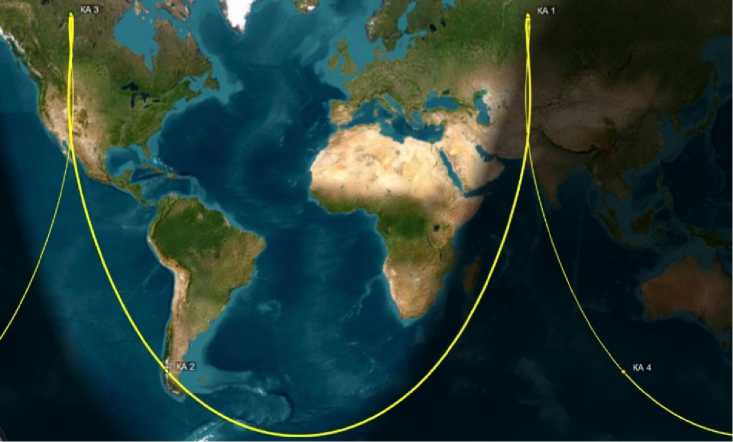
Рис. 1. Наземная трасса ВЭО
Fig. 1. HEO ground track
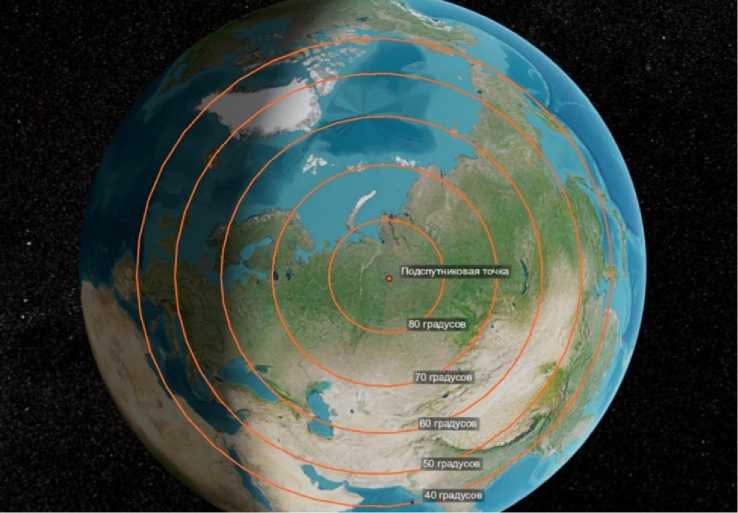
Рис. 2. Углы места абонентов, обслуживаемых с основного витка, из точки апогея
-
Fig. 2. Elevation angles of subscribers served from the main turn from the apogee
The payload includes Ku- and L/C-band equipment. The L/C-band payload is intended to form a quasi-global coverage area using one beam from the main and one from the conjugate orbit. Fig. 3, a, b show the quasi-global coverage area with beams 12.5 °.
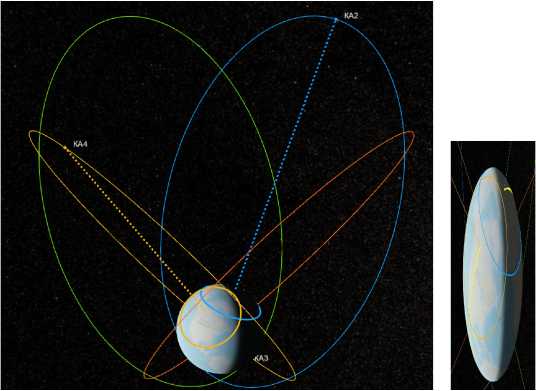
а
б
Рис. 3. Квазиглобальная зона обслуживания полезной нагрузки L/C-диапазона
-
Fig. 3. Quasi-global coverage area of the L/C-band payload
Multi-beam coverage of service area
One of the modern trends in the development of satellite systems is the transition to the development of groups with increased throughput (High Throughput Satellite, HTS) [6; 7]. This is possible due to multi-beam coverage of the service area, which allows increasing the system's throughput by reusing frequencies in different beams and providing a gain in the energy of the radio link due to a higher directivity of the antennas. Reusing frequencies allows increasing the number of channels and, ultimately, the overall throughput of the system without expanding the range of operating frequencies. The system under consideration, strictly speaking, cannot be classified as a system with increased throughput, since it has a frequency reuse factor of 11/6, but its development is an important stage in the transition to such systems.
Fig. 4 shows the coverage area formed by the Ku-band payload when the spacecraft is at the apogee point.
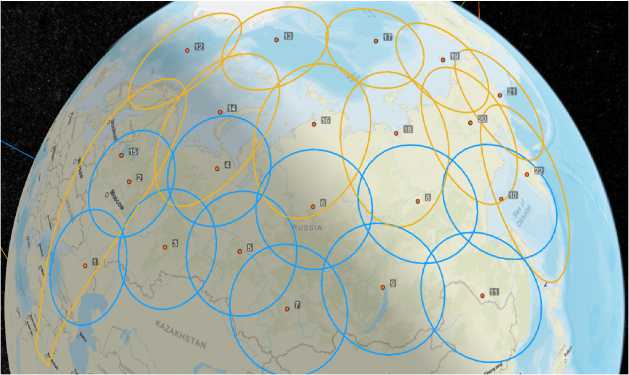
Рис. 4. Зона покрытия полезной нагрузки Ku-диапазона из апогея
-
Fig. 4. Coverage area of the Ku-band payload from the apogee
It is evident from Fig. 4 that coverage of the specified territory is provided by eleven beams with a width of 2.2° when operating on the main (blue) and conjugate (yellow) orbits.
Covering the service area with several highly directional beams instead of one beam provides a significant advantage in the gain of the satellite transmitting antenna. This allows the size of the subscriber terminal antenna to be significantly reduced.
The Ku-band frequency range was chosen to implement multi-beam coverage. The attenuation of the signal with a frequency of 14 GHz when passing through the atmosphere is shown in Fig. 5 for all possible elevation angles on the main loop.
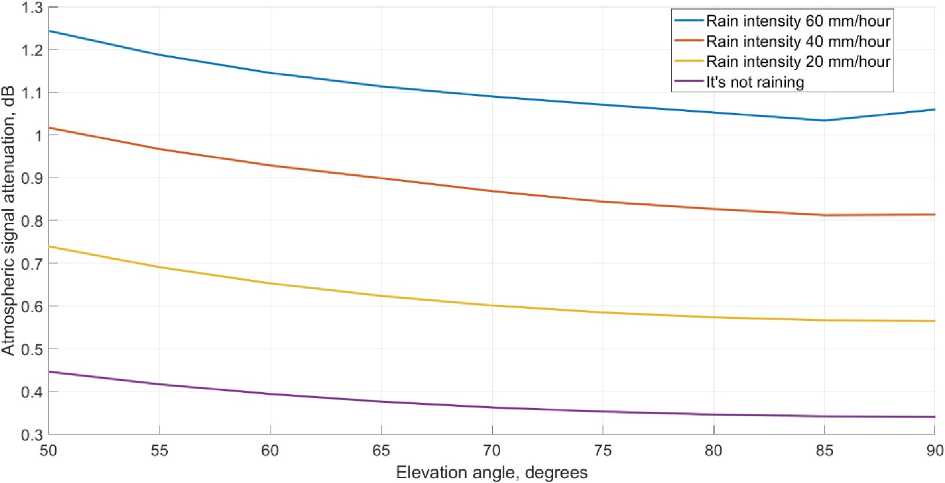
Рис. 5. Ослабление сигнала в атмосфере
-
Fig. 5. Signal attenuation in the atmosphere
The attenuation is calculated in accordance with the recommendations of the International Telecommunication Union [8]. The total signal attenuation consists of attenuation due to rain, clouds, atmospheric gases and tropospheric scintillation. The probability of exceeding the signal attenuation relative to the value used for each signal attenuation factor from the recommendation [8] is taken to be 1%. From Fig. 5 it is evident that the main contribution to signal attenuation in the Ku-band is made by precipitation and even with very heavy rain with an intensity of 60 mm/h, the signal attenuation in the atmosphere is slightly more than 1.4 dB.
Network architecture
The operation of the satellite system is based on a star topology, the operating principle of which is explained in Fig. 6.
The forward channel of the satellite system provides for time division multiple access (TDMA), in which information is transmitted to subscribers within each beam on a single carrier. The DVB-S2X standard was chosen to implement the physical layer of the modem equipment of the direct channel. In the return channel, frequency-time division of subscribers (MF-TDMA) is used. Signal processing in the return channel is implemented according to the DVB-RCS2 standard. The possibility of using the DVB-S2X and DVB-RCS2 standards in non-geostationary systems has been discussed many times [9– 13]. The channel level of the modem equipment is implemented using the GSE and RLE protocols in the forward and reverse channels, respectively. The symbol rate in the forward and reverse channels is 0.7–54 and 0.1–8 Msymbols/s.
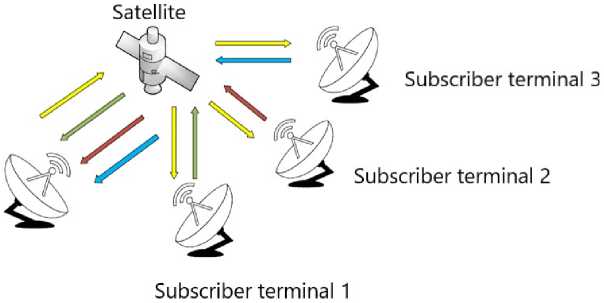
Ground station
Рис. 6. Топология сети «звезда»
Fig. 6. Star network topology
Payload structure of forward and reverse channel
The Ku-band payload includes eleven forward (excluding additional) and eleven return channels, as well as one radio beacon, the signal from which is used to track the spacecraft's orbital motion. We consider a simplified diagram of the forward channels of the Ku-band payload, shown in Fig. 7.
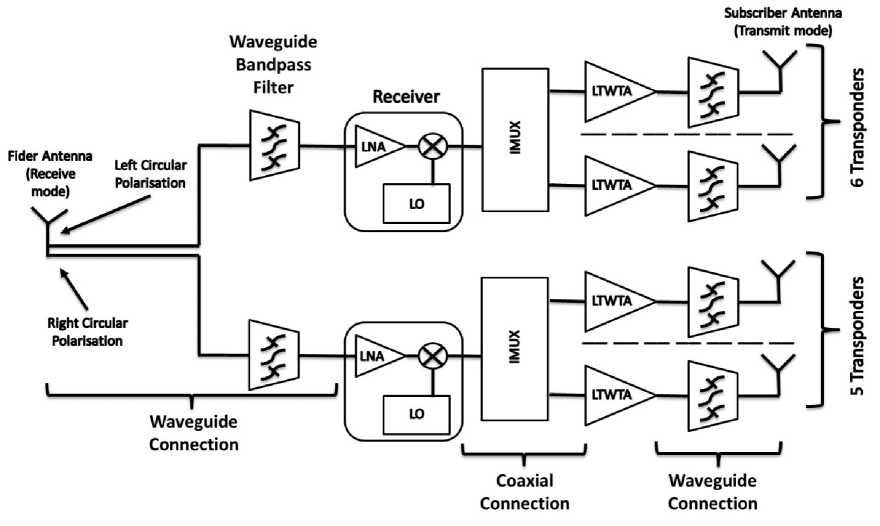
Рис. 7. Упрощенная функциональная схема прямых каналов полезной нагрузки Ku-диапазона
Fig. 7. Simplified functional diagram of Ku-band payload forward channels
The simplified functional diagram does not show the backup elements that ensure the operation of the payload in the event of failure of the main elements, their switching circuits, additional channels built on the backup elements, and the beacon equipment.
The group signal generated in the modem equipment is emitted by the antenna of the satellite communications center. The emitted signal has left and right circular polarization. The signal with orthogonal polarizations is recorded by the feeder satellite antenna operating in the reception mode. The signal from the output ports of the antenna is passed through a waveguide bandpass filter designed to filter out-of-band radiation, and then goes to the input of the receiver. The receiver provides preliminary amplification and single frequency conversion of the signal, which is necessary for isolating the downlink and uplink lines.
The signal from the receiver output is fed to the input multiplexer, which is a set of bandpass filters. In the input multiplexer, channels with 70 MHz bands are selected from the entire frequency range, which are amplified in a linearized traveling-wave tube power amplifier (LTPTA). Guard bands with a width of 16 MHz are provided to separate adjacent channels.
The amplified signal is passed through an output filter. Filtering is necessary to eliminate parasitic effects that occur in a high-power amplifier and have a negative effect on the signal. An example of such an effect is multiple harmonics in the signal spectrum generated by nonlinear elements. At the final stage, signals with a 70 MHz band are radiated by antennas with a parabolic reflector in the direction of the specified aiming points.
According to the requirements, reservation of active retransmission equipment is provided, the failure of which leads to the loss of transponder functionality: receivers, LTPTA, antennas and their switching circuits. Reservation of passive retransmission equipment (filters and multiplexers) is not provided, since its failure is unlikely.
To increase the data transfer rate, three additional channels are provided in three transponders, the operation of which is based on an additional receiver and backup LTPTA. To combine the three additional channels with the three main ones, an output multiplexer is installed after the output filter. To control the connection of additional channels and individual backup elements in the event of failure of the main ones, a backup ring is used, the operation of which is regulated by multi-position switches.
Next, we will consider a simplified diagram of the payload of the Ku-band return channels, shown in Fig. 8.
In the return channels, subscriber terminals distributed throughout the coverage area of eleven regions emit signals in the direction of the spacecraft. The signals are received by the corresponding eleven subscriber antennas on board the spacecraft. The signal from the antenna output is passed through a bandpass waveguide filter, in which the general range of operating frequencies of the return channels in the uplink is selected and at the same time out-of-band radiation is filtered. The bandwidth of one channel is 36 or 54 MHz.
The signal then enters the receiver input, where signal amplification and single frequency conversion are performed. At the next conversion stage, five or six adjacent channels are combined into a group signal in the multiplexer. The resulting signal is amplified using a high-power linearized amplifier.
Next, the group signal is passed through a waveguide filter to eliminate the influence of negative effects that occur during amplification: intermodulation products and multiple harmonics. At the final stage, signals with left and right circular polarization are fed to the ports of the feeder antenna.
Similar to direct channels, in the return channels in case of failure of the main active retransmission equipment, its backup is provided. To control the connection of individual backup elements, a backup ring is used, the operation of which is based on multi-position switches.
The highly elliptical orbit is characterized by a strong Doppler shift. Therefore, the initial frequency bands of the payload equipment are extended by the maximum Doppler shift in the uplinks of the forward and return channels. Figure 9 shows the time dependence of the Doppler shift in the working section of the orbit (for the uplink and common). The Doppler shift is calculated for transmission frequencies of 14 GHz on the uplink and 11 GHz on the downlink.
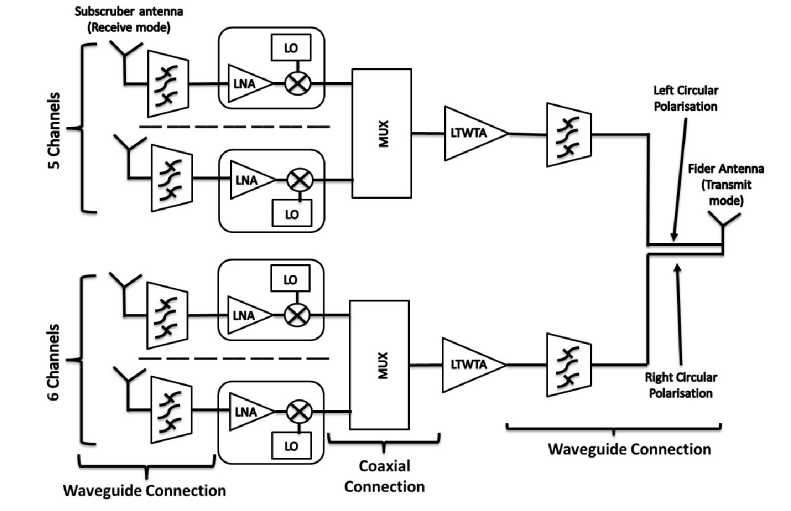
Рис. 8. Упрощенная функциональная схема обратных каналов полезной нагрузки Ku-диапазона
Fig. 8. Simplified functional diagram of Ku-band payload return channels
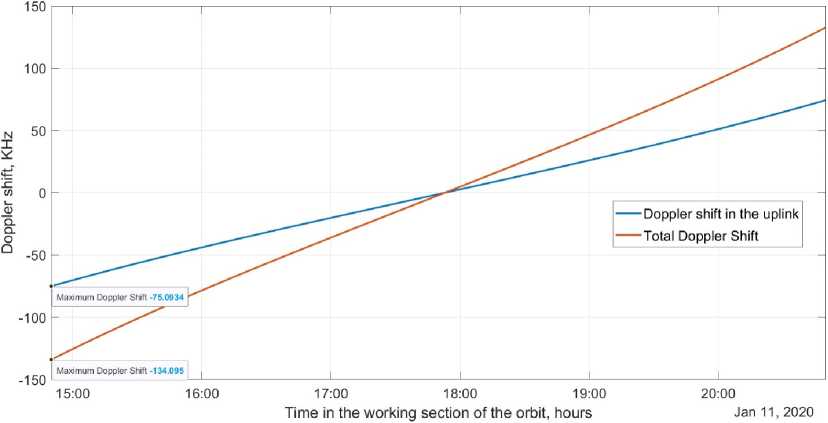
Рис. 9. Доплеровское смещение на линии «вверх» и суммарное доплеровское смещение
Fig. 9. Doppler shift on the uplink and total doppler shift
Forward Channel Signal-to-Noise Ratio Estimation
Direct signal retransmission and a long radio path impose strict restrictions on the energy budget of the radio link, especially in the return channel, so the calculation of the signal-to-noise ratio in the system is given below.
The calculation of the energy budget of the radio link was made for the apogee point (the worst case) and for the subscriber terminal with a parabolic reflector diameter of 0.6, 0.9 and 1.2 m. The parameters for calculating the energy budget of the radio link in the forward channel are presented in Table 2.
Table 2
|
Parameter |
Value |
|
|
General parameters |
Rain intensity, mm/h |
60 |
|
Bandwidth, MHz |
70 |
|
|
Rounding factor |
0,2 |
|
|
Ascending channel |
EIRP of the antenna of the CSS, dBW |
67,1 |
|
Frequency, GHz |
13 |
|
|
Free space attenuation, dB |
206,7 |
|
|
Attenuation in the atmosphere, dB |
0,96 |
|
|
Spacecraft transponder |
Gain factor (GF) of the receiving antenna of the spacecraft, dBi |
37,1 |
|
Signal amplification to power level, W |
150 |
|
|
Noise temperature of the spacecraft transponder, K |
476,81 |
|
|
Signal-to-noise ratio on the satellite side, dB |
19,91 |
|
|
Gain of the transmitting antenna of the spacecraft, dBi |
32,85 |
|
|
Descending channel |
Frequency, GHz |
11 |
|
Free space attenuation, dB |
205,5 |
|
|
Attenuation in the atmosphere, dB |
0,83 |
|
|
Subscriber antenna diameter , m |
0,6/0,9/1,2 |
|
|
Subscriber antenna efficiency |
0,5 |
|
|
Noise temperature of subscriber terminal, K |
226 |
|
|
Angle of elevation , ° |
60 |
|
|
Signal-to-noise ratio on the subscriber side, dB |
8,53/11,68/13,7 |
|
|
E s /N 0 , dB |
9,32/12,47/14,49 |
|
|
G/T, dB /К |
9,92/13,06/15,08 |
Parameters for calculating the energy of a radio link in a direct channel
To calculate the signal-to-noise ratio, the signal power recorded by the subscriber's antenna is calculated as
P sub = ER G - FSPLu - I *" + G S* + G R. + GT a - FSPLd - /R + G* (дБВт), (1)
where– EIRP antennas of the CSS , FSPLU и FSPLD is signal attenuation in the uplink and down-Atm Atm Rx Tx link ; LU и LD is atmospheric weakening; GSat и GSat is GF of the receiving and transmitting antennas of the spacecraft; GSRuxb is Subscriber's antenna gain; GSRaetp is GF for retransmission on board a spacecraft.
When calculating the energy budget of a radio link, the noise temperature is used, reduced to the input of the subscriber terminal:
G u
TE= TSub + TSat -1010 , were TSub is subscriber terminal noise temperature; TSat is spacecraft noise temperature; Gu is noise temperature reduction factor, which is calculated as
Gu = G + GP - FSPLd - / . + G^ (dB),(3)
The signal-to-noise ratio SNR Sub at the subscriber side is calculated as follows:
SNRsub = PSub -10 Log io (kBTz),(4)
where В is strip width; k is Boltzmann constant.
Hence, the ratio of the symbol energy to the noise spectral density is equal to [14]
-S- = SNRS ub + 10 Log 10 (1 + a ), N 0
ES were a is rounding factor of the shaping filter ; n is symbol energy to noise spectral density ratio.
The performance data of the DVB-S2X standard are presented in [14] for various combinations of code rate and modulation type (data corresponding to the linear mode of operation of the on-board amplifier are considered). The performance results correspond to the case of ideal synchronization and the absence of phase noise. Thus, in [14] for each operating mode, the value is determined at which a given level of packet error probability FER = 10 5 is achieved (quasi-error-free reception).
The calculated values allow working with the BPSK, QPSK, 8PSK, 8APSK modulation types without restrictions. For a subscriber terminal with an antenna diameter of 0.6 m for several code rates in modes with 16APSK modulation, the value in the standard exceeds the calculated value and does not provide the target value of the packet error from the standard. For example, according to the standard, in the operating mode with 16APSK modulation and a code rate of 13/18 for a normal frame, ES quasi-error-free reception is ensured at n0 9,7 dB.
It should be noted that according to the DVB-S2X standard, the signal transmission to subscribers within each beam is performed on one carrier (time division multiplexing, TDMA). For operation, each subscriber is allocated a time slot of a radio frame formed in accordance with a certain transmission mode. Since the transmission mode within one radio frame remains constant, it will be selected for the subscriber in the most unfavorable communication conditions, i.e., having the smallest val
ES ue N0 . This neutralizes the benefit of using antennas with different aperture diameters in the forward channel and is a serious inefficiency of the entire system.
One of the advantages of DVB-S2X compared to DVB-S2 is its extended capabilities in the area of high signal-to-noise ratios [15; 16]. Thus, with a signal-to-noise ratio of 20 dB, the algorithms of the extended version of the standard (DVB-S2X) provide a spectral efficiency gain of 51% compared to DVB-S2. Evaluation of the signal-to-noise ratio showed that a significant part of the improvements of the algorithms of the extended version of the standard (DVB-S2X) is unused in the worst-case communication scenario under consideration, which is another disadvantage of the system. On the other hand, the basic scenario of the system will be characterized by a slightly higher signal-to-noise ratio than the worst one.
Estimation of signal-to-noise ratio in the return channel
The signal/noise ratio in the return channel is calculated similarly. The calculation parameters are presented in Table 3.
Performance data for the DVB-RCS2 standard is provided in the specification [17]. The calculated values allow a subscriber with a 0.6 m antenna to operate in QPSK and BPSK modulation modes, but the value is insufficient to support other modulation types. A slightly higher received power by a subscriber with a 0.9 m antenna allows for operation in some modes with 8PSK modulation, 1.2 m – to use some modes with 16QAM modulation. Thus, the possibility of the communication system operating in the return channel is confirmed, but the lack of the ability to operate in the high value range is a disadvantage that limits the maximum symbol rate in the return channel.
Table 3
Parameters for calculating the energy of a radio link in the return channel
|
Parameter |
Value |
|
|
General parameters |
Rain intensity, mm/h |
60 |
|
Bandwidth, MHz |
2,4 |
|
|
Rounding factor |
0,2 |
|
|
Ascending channel |
EIRP of the antenna of the CSS, dBW |
44/47,5/50 |
|
Frequency, GHz |
14 |
|
|
Free space attenuation, dB |
208 |
|
|
Attenuation in the atmosphere, dB |
1,14 |
|
|
Spacecraft transponder |
Gain factor (GF) of the receiving antenna of the spacecraft, dBi |
33,15 |
|
Signal amplification to power level, W |
150 |
|
|
Noise temperature of the spacecraft transponder, K |
478,5 |
|
|
Signal-to-noise ratio on the satellite side, dB |
6,01/9,51/12,01 |
|
|
Gain of the transmitting antenna of the spacecraft, dBi |
35,97 |
|
|
Descending channel |
Frequency, GHz |
11 |
|
Free space attenuation, dB |
205,5 |
|
|
Attenuation in the atmosphere, dB |
0,64 |
|
|
Subscriber antenna diameter , m |
7,5 |
|
|
Subscriber antenna efficiency |
0,8 |
|
|
Noise temperature of subscriber terminal, K |
179 |
|
|
Angle of elevation , ° |
60 |
|
|
Signal-to-noise ratio on the subscriber side, dB |
6,01/9,51/12,01 |
|
|
E s /N 0 , dB |
6,8/10,3/12,8 |
Conclusion
The paper examines the Express-RV satellite system, which is the first step in the development of HTS systems in Russia. The key feature is the multi-beam Ku-band payload, designed to cover the service area with highly directional beams, so it is considered in more detail.
The energy budget of the radio link in the forward and reverse channels was calculated, which
ES made it possible to estimate the relationship N0 in the communication system. Based on the evalua- tion results, a conclusion was made about the system’s operability. For the return channel for 3 types of subscriber terminals, the modulation types from the DVB-RCS2 standard that will actually be used in the system are defined. For the direct channel, it has been established that the transmission mode is selected based on the subscriber who is in the most unfavorable communication conditions (in the
ES worst case, the value is N0 9.32 dB).Therefore, there is no benefit from using antennas with a larger aperture diameter, indicating serious inefficiency. In addition, the significant capabilities of DVB-S2X
ES for working in the high ratio range N0 are not utilized.

